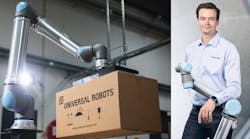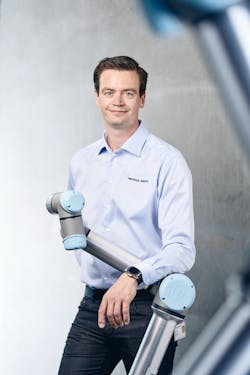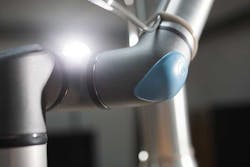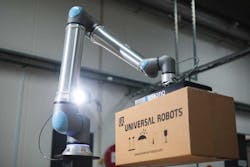Universal Robots’ Latest Cobot is Redesigned for Palletizing
At a Glance:
- Danish manufacturer Universal Robots designed its UR20 cobot for welding, material handling, machine loading and tending, among other repetitive and strenuous tasks.
- The UR20 is a workhorse capable of handling heavier loads on significantly faster cycle times, and with greater reach in a small footprint.
- Anders Beck, vice president, Strategy and Innovation, Universal Robots, discusses the automation platform’s new features, including the tool flange and joint design.
WATCH THE VIDEO: UR’s Latest Cobot is Designed for Higher Payloads
Ever since robots were deployed to the production floor in the late 1990s, humans have associated these workhorses with disappearing jobs. That argument has steadily been supplanted with the development of cobots—collaborative robots—that are programmed for division of labor and to work safely alongside their human colleagues.
As a subset of industrial robotics, cobots are largely designed to automate monotonous, strenuous, repetitive, heavy-lifting tasks that are a bane for humans. Since they operate alongside people, safety is central to the design. In addition to the power and force limiting (PFL) features built into the cobot, standards define the creation of a shared collaborative work space that will allow close but safe interaction between the cobot and operating staff.
If you look at the robotic standards, collaborative robots are defined by a number of modes of collaborating with robots (global standard ISO/TS 15066), said Anders Beck, a roboticist and vice president, Strategy and Innovation, Universal Robots. “And one of them is a safety feature ensuring the cobot can detect contact between humans and the robot, so that it stops and keeps them safe from harm.”
Cobots also need to be “very easy to use, very easy to install, very simple and don’t require a lot of expertise,” Beck told Machine Design during an exclusive introduction to Universal Robot’s latest offering, the UR20.
Lightweight Form Factor
Redesigned from the ground up, the UR20 has a reach of 1,750 millimeters, can carry a full payload of 20 kg (44 lb.), weighs 64 kg (141 lb.) and has six rotating joints. A combination of materials (aluminum, plastic and steel) makes it lightweight and compact compared to other robots of its size with similar capabilities. These specs qualify the UR20 as the lightest long-reach collaborative robot on the market and can be useful both as a technical tool and as a manual laborer.
“It’s been designed this way to handle applications where you need a larger workspace,” explained Beck. “Palletizing is a core application, where we have a lot of people lifting, stacking heavy boxes, putting them on pallets and doing that on a day-to-day basis. The UR20 is designed to be fully capable of stacking a Euro or American pallet, all the way to two meters in height, which is the average height you stack before loading them onto trucks. It is designed to automate jobs where you would need two hands.”
Reimagining the Drive Train
The journey to the UR20 has been relatively long for the Danish manufacturer, said Beck, partly because UR’s engineers needed to balance high performance with collaborative safety capabilities that require strong, lightweight construction. In short, the assignment was to reimagine the whole drive train.
“We really started all the way from scratch, threw away everything we knew, looked at all the new technologies that came in, sorted them, ranked them, developed prototypes and, in the end, came up with something that is our new design today,” Beck said.
Back in 2018, when the UR launched its e-Series, engineers were already rethinking the overall mechanical design of the cobot. “We wanted something that was simpler, we wanted something that was more powerful and we wanted something that was even more manufacturable,” recalled Beck.
For starters, the base joints of the UR20 produces more than 700 Newton-meters of torque, pointed out Beck. “It is really a massive amount of torque generated in a very, very compact form. I mean, 700 Newton-meters is more than a performance model Tesla would produce on all of its wheels. So, it’s really a lot of power generated on a very small package. It took us more than three years to build a design that could do that.”
The design team took a broad approach by looking, for example, at whether they could design a system without gearboxes. “That would mean a lot, both in terms of cost and in terms of performance, but we learned that for now there probably is no technology on the market that can create a self-carrying construction without gearboxes—at least not effectively,” Beck said.
The current design does house a gearbox, but the whole structure was redesigned to accommodate a double encoding system. “We have an output shaft that has an output side that carries the robot, we have an input side, where we have a high spinning motor, and we have a high ratio reduction gearbox in between,” explained Beck. “And we have encoders on both sides, so we always know what the output position of the joint is and we always know very accurately what the motor side is. And we use all of these factors—both for controlling the robot and for safety purposes. But it all creates a very complex tolerance chain.”
Undoubtedly, if robots are to perform tasks effectively without human intervention, their ability to detect and tolerate internal failure modes are critical, and the high-performance motor units needed to tolerate high demand and high performance.
“Remember that a robot of the UR20 size ( that is a reach of 1,750 mm ) still has an accuracy of 50 microns (or at least repeatability of 50 microns); this is a high-performing and very accurate drive unit,” Beck said. “We really went through it, we visited all the construction parts, we managed to cut away most of the critical tolerance change we had—where we were either putting very, very high demands on ourselves and our assembly in the engineering process, or even our sub-suppliers—to make that significantly simpler.” For their effort, the UR engineers could boast of a part reduction by more than 50% in the new unit’s design, when compared to existing units.
Beck demonstrated how a housing from an existing product (e-Series) with holes on either side had been redesigned to incorporate a lid. In the new design, the housing is lighter, stiffer and stronger. For manufacturability, the drive unit can be built as a single unit and can be inserted as an independent part, which further simplifies the assembly process and quality outcome.
Reducing the number of parts gives immediate wins on product quality, said Beck. “We really did a lot of engineering work just to make sure we have something that’s much more manufacturable…and wanted a product that could scale with us. And this new design can do that.”
READ MORE: Automate 2022: Machine Vision Solutions Point to the Future of Automation
Changes to Base and Tool Flange
A visible change is the size of the mounting base, which measures 245 mm. (In contrast, the UR10 has a footprint of 190 mm.) The UR20's larger base means more volts and more torque or momentum for carrying out work, and Beck pointed out that the cobot still remains slim compared to other robots of its size.
Another important change that end-users will observe is that the new tool flange (the point where one mounts a tool to the robot) is larger. Tool flanges on predecessor cobots have eight-pin connectors that have become the de facto industry standard. Therefore, all of the available tooling on the market today will need the available adapter, said Beck.
“When you’re carrying the 20 kg payloads at the speeds that your UR20 is capable of, then the secure way of mounting tools on a robot is using the UR20 tool flange size,” said Beck. “Otherwise, we’ll be stretching bolts and the sides all the way and maybe even a little past the limits…For us it was really important to make the right design decisions, and to also make sure that the product we had was really thoughtfully designed and led the way to success for customers.”
The UR20 also launches with the newest version of PolyScope software, and Beck said that programming and getting the cobot ready for the shop floor can be done in a day or two.
Doing the Heavy Lifting
Adding a cobot with a heavier payload and long reach also signals a competitive move for UR, which is owned by Teradyne. Others who lead in this category include Fanuc’s CR-35iA (a 35-kg payload) and Yaskawa Motoman HC30PL.
UR launched the world’s first commercially viable cobot in 2008 and, at last count according to UR’s press materials, has since built an ecosystem of more than 1,100 integrators, distributors and independent partners creating components, kits and applications for its cobots.
According to Beck, UR is now responding to a demand for cobots that can do both heavy lifting and moving. Palletizing is a rapidly growing application area within food and beverage, alongside metal machining and general manufacturing, he said. Welding is another application area that has seen high growth over the past couple of years.
Geographically, the trend is extended to lower-cost countries, such as India and China, where there is a high demand on automating tasks. The UR20 can be deployed for tasks in pharmaceutical and semiconductor manufacturing as well, but “it is not a robot designed for being in the most holy parts of the clean room,” Beck said.
“Having a robot that’s fairly lightweight for its size, that is perfectly designed for retrofits and can be housed close to existing machinery, but can handle heavy loads and also extend the arm fairly far, that’s a sweet spot for the UR20,” he said.
Given the number of partners who approached UR at Automatica (an international smart automation trade fair in Munich, Germany) with great ideas about how the novel ways the UR20 could be deployed, Beck can be confident the true limits to the UR20’s applications will be revealed once it hits the market in Q2 of 2023.




![Palettizing is a core function of the UR20, along with welding, material handling, machine loading and machine tending. “[The UR20] is designed to automate jobs where you would need two hands,” said Anders Beck, vice president, Strategy and Innovation, Universal Robots. Palettizing is a core function of the UR20, along with welding, material handling, machine loading and machine tending. “[The UR20] is designed to automate jobs where you would need two hands,” said Anders Beck, vice president, Strategy and Innovation, Universal Robots.](https://img.machinedesign.com/files/base/ebm/machinedesign/image/2022/07/Palletizing_Overview_Distance.62dae8875007b.png?auto=format,compress&fit=max&q=45&w=250&width=250)
